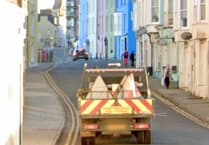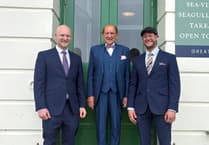On the evening of September 6, intrigued by the title 'Remembering Manorbier', a capacity audience turned out to welcome Mrs. June Stevenson.
As was immediately apparent from the buzz of interest, they were not to be disappointed. It was quite remarkable how many of those present proved to have an active involvement with the past of Manorbier encompassed in the talk, either by dint of occupying one of the fine old houses or by the numerous mentions of family names and connections.
June Stevenson was brought up in the village for the first 15 years of her life. The daughter of the Rev. Percy Rigby, her family have been traced back to the early 18th century in North Pembrokeshire and later, Carew, Lamphey, Manorbier and Penally.
She began with a short history lesson on the involvement of Manorbier and Tenby in the doings of Kings, Queens and Nobles of the past, from Geraldus Cambrensis, born in Manorbier Castle 1147, to William De Valence, half brother to King Henry III, from whom the 'De Valence Pavilion' in Tenby takes its name.
Later, a Welshman, Owen Tudor, married Henry V's widow, Catherine, and their son Henry, born in Pembroke Castle, became King Henry VII. He, as a teenager, had escaped the Yorkists with the help of his Uncle Jasper and fled to France via an underground passage in what is now 'Jasperly House' or 'Boots the Chemist' in Tudor Square, Tenby.
However, it was Henry's mother, Margaret Beaufort, great-great-granddaughter of Edward III, through his son, John of Gaunt, who had a particular relevance in Mrs. Stevenson's connection with Manorbier.
As Dowager Countess of Pembroke, she owned land in the village and had the right to appoint an incumbent. She founded two Cambridge colleges - St. John's and Christ's. To Christ's she passed the right to appoint its own vicar of Manorbier, and many hundreds of years later in 1914 they appointed Mrs. Stevenson's father, a graduate of Christ's and a priest, "and that," she says, "is how I come to be here."
Her mother remained Pembrokeshire to her fingerprints. The expression 'over the water' did not mean France, but the other side of Milford Haven, and she claimed never to feel well in England.
The talk moved on to cover the community of Manorbier in the early 1920s and '30s. It was a stratified society - there were class divisions - 'gentlemen' occupying the grand houses, then the farm owners, next came the craftsmen, and socially the bottom stratum, of farmworkers.
Manorbier was self-sufficient in its skills. Food was grown in gardens and a pig kept in a sty adjacent to the house. The women sewed by hand their husband's thick flannel workshirts. A washerwoman walked between Jameston and Manorbier with a large wicker basket or laundry on her head.
Various important events in the village were covered and illustrated with old photographs, which attracted a great deal of interest from the audience later. There were many amusing anecdotes of long- gone colourful characters which, Mrs. Stevenson said, "regrettably we don't see the likes of today."
The chairman thanked her for sharing the wealth of memories of what she says modestly, "is turning out to be a rather long life."
The next meeting will be at 7.30 pm at the Skrinkle Centre on October 4 - the talk to be 'Experiences of an Evacuee' by Frank Harbud. New members and guests are very warmly welcomed. For further details, please contact Denise on (01834) 871209.



